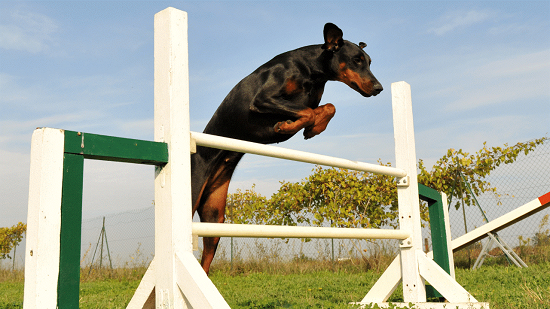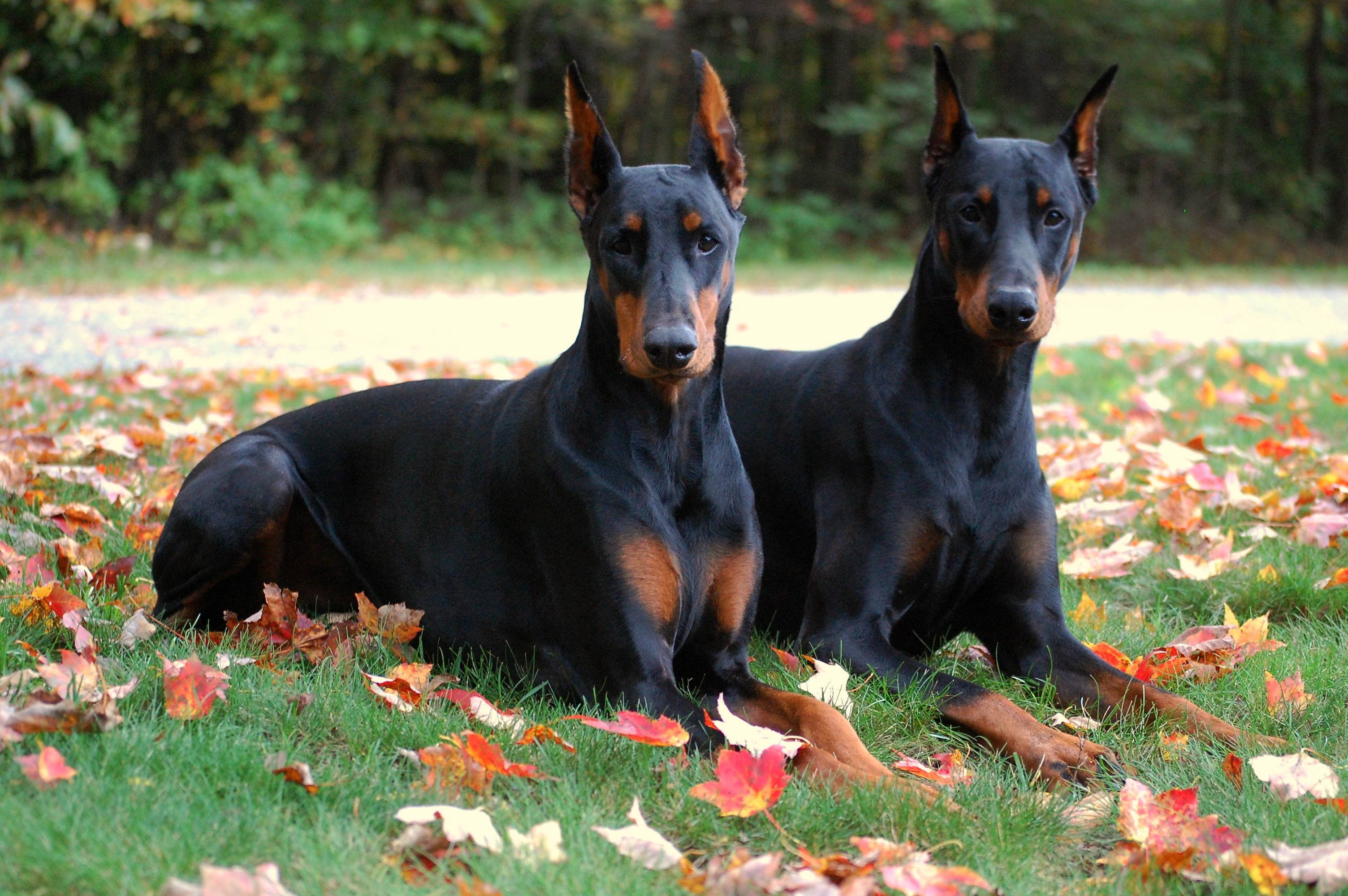Understanding Doberman Weight Care: A Guide to Exercise and Activity

[ad_1]
If you are extremely outgoing and have a true love for petting dogs, you would surely want a large-sized, short-haired, sleek but strong guard dog. A dog who can protect your neighborhood and livestock, accompany you on hikes and be a little goofy with your family. All these filters will lead you to none other than a Doberman Pinscher. Their impressive looks and guarding abilities are already a chartbuster in popularity. However, another aspect of Dobermans that often piques curiosity is the Doberman Weight care.
A Doberman Pinscher is a highly intelligent dog breed. They are the 3rd most preferred breeds for canine security forces after German Shepherds and Belgian Malinois, especially due to their physical build. Understanding their exercise needs is essential for their health and well-being, as these athletic canines require regular physical activity to thrive.
In this blog post, we’ll delve into the factors that influence Doberman weight, explore the ideal weight range for this breed, and discuss various ideas to ensure your ”dobby” maintains a healthy Doberman weight.
Type of Doberman
Before we begin the guide to the ideal Doberman weight, let us understand the two primary types of Doberman generally found. 1. American Doberman and 2. European Doberman.
Both breeds were found in the 1890s in Germany by Louis Dobermann, a tax collector. From there, the doberman brought to America for breeding came to be known as the American Doberman, and the one taken to Europe for ZTP testing was known as the European Doberman.
While both breeds have a similar bite force of 280-305 PSI, an American Doberman can reach a shoulder height of up to 61-72 cm with a weight between 27-45 kg. Its European counterpart can grow up to 64-75 cm, weighing 30-48 kg. This explains the European Doberman’s muscular build. Want to know more about this breed? Here are some amazing facts about Doberman Pinscher.
The Ideal Doberman Weight Chart
Time flies when you’re having fun with a Doberman puppy. From teaching them new tricks to potty training, the early days are filled with joy and excitement. Save this chart to ensure your pup is growing ideally.
| Age (months) | Male Weight (lb) | Male Weight (kg) | Female Weight (lb) | Female Weight (kg) |
| 1 | 5-10 | 2.3-4.5 | 5-10 | 2.3-4.5 |
| 2 | 15-25 | 6.8-11.3 | 10-20 | 4.5-9.1 |
| 3 | 25-35 | 11.3-15.9 | 20-30 | 9.1-13.6 |
| 4 | 40-50 | 18.1-22.7 | 35-45 | 15.9-20.4 |
| 5 | 45-55 | 20.4-24.9 | 40-50 | 18.1-22.7 |
| 6 | 50-65 | 22.7-29.5 | 45-55 | 20.4-24.9 |
| 7 | 55-70 | 24.9-31.8 | 50-60 | 22.7-27.2 |
| 8 | 60-70 | 27.2-31.8 | 55-65 | 24.9-29.5 |
| 9 | 65-80 | 29.5-36.3 | 60-70 | 27.2-31.8 |
| 10 | 70-85 | 31.8-38.6 | 60-75 | 27.2-34.0 |
| 11 | 70-90 | 31.8-40.8 | 60-80 | 27.2-36.3 |
| 12 | 75-95 | 34.0-43.1 | 60-85 | 27.2-38.6 |
| 24+ | 75-100 | 34.0-45.4 | 60-90 | 27.2-40.8 |
This weight chart can give you a general idea of your puppy’s weight. However, to quickly judge if your dog is eating too many treats or looking too skinny, you must take a closer look.
While external factors like environment, stimulation, and exercise vary the dog’s weight. If you can feel your dog’s ribs while playing tug of war with you, he might need a better nutrient-rich diet. However, If you see your dog gaining more body mass than the ideals mentioned above, you should reassess how much exercise your dog is getting.
How Much Exercise Equals Ideal Doberman Weight
Generally, Most Dobermans need 1-2 hours of exercise daily. This may sound daunting, but it can easily be broken into manageable daily sessions. For example, an early morning walk for 30 minutes would set the pace for multiple short playtime sessions later in the day.
It is essential to understand that every Doberman is a unique animal. Factors like age and health impact their needs, with some needing more activity to release energy. Always pay attention to your dog’s behavior and adjust their activity levels accordingly.
Engaging Their Mind and Body
Dobermans need mental stimulation in addition to physical exercise. Preventing boredom and destructive behaviors in your Doberman can be achieved by keeping them mentally stimulated.
Here are some methods to include cognitive challenges in their daily schedule:
- Interactive Toys: Use interactive puzzle toys for mental stimulation and treat rewards.
- Training Sessions: Train your Doberman with new commands for bonding and mental exercise.
- Agility Training: Create an agility course for physical and mental challenges in your backyard.
Signs of Insufficient Exercise
Be observant of your Doberman’s actions to determine if they are receiving sufficient physical activity. Indicators that your dog might require additional exercise are:
- Pacing around the house
- Barking or howling excessively
- Destructive behaviors, mainly when left alone
- Hyperactivity or restlessness
If you notice these behaviors, increasing your daily exercise routine might be the right call.
Fun Activity Ideas for Doberman
Consider incorporating some fun activities into their routine to keep your Doberman engaged and active. Here are eight unique ideas:
- Water Fetch: On a hot day, throw a toy into the water for your Doberman to retrieve. This not only provides exercise but also keeps them cool.
- Delayed Fetch: Teach your dog to wait before fetching a ball. This adds an obedience element to playtime.
- Find It: Hide your dog’s favorite toy in the house and encourage them to find it. This game is great for stimulating their mind and using that long sensitive muzzle.
- Obstacle Course: Create a simple obstacle course using household items to challenge your dog physically and mentally.
- Bubble Chase: Blow dog-safe bubbles and watch your Doberman have a blast trying to catch them.
- Hide and Seek: Have your Doberman stay while you hide, then call them to find you. This game encourages them to use their senses.
Consider Getting a Second Dog
If your lifestyle allows, consider getting a second Doberman into your household. Having two dogs can balance energy levels, provide companionship, and enrich each other’s lives through exercise and companionship.
Monitor Your Doberman’s Weight
Keeping your Doberman at a healthy weight is crucial for their overall well-being. Exercising regularly and maintaining a balanced diet can assist in controlling their weight. Keep an eye on their physical condition and talk to your vet if you are worried about their weight.
Equip Yourself with the Right Gear
Investing in appropriate gear can enhance your Doberman’s exercise experience. Consider getting:
- High-quality toys: Durable toys designed for active play can withstand your Doberman’s energy.
- Walking and hiking gear: Proper harnesses and leashes can make outdoor activities safer and more enjoyable.
- Hygiene products: Keeping your Doberman clean and healthy is crucial, so consider grooming tools and hygiene products.
Create a Routine
Establish a routine that includes regular exercise and playtime for your Doberman’s well-being. Aim for consistency in their daily activities and adjust based on their needs, energy levels, and preferences.
Include both physical and mental exercises to keep your Doberman busy and happy. A well-rounded routine will contribute to a healthy weight and a fulfilling life.
Behavioral profile of the Doberman Pinscher
To all those mesmerized by the charm of a Doberman and willing to welcome a Dobby puppy to your clan, here is a graph that represents the behavioral profile of the Doberman Pinscher you can take as a guide.
Positive Traits:
- High trainability: Dobermans are recognized for their cleverness and willingness to make their owners happy, making them quite trainable. This qualifies them as strong contenders for different positions, such as service, therapy, and working dogs.
- Low excessive barking: Although Dobermans may bark to protect, they are not usually known for barking excessively. This feature makes them ideal for residences or flats where too much noise is an issue.
- Moderate demand for affection: Dobermans require a moderate amount of love and attention from their owners. They like to spend quality time with their families without asking for too much.
Areas of Caution:
- Territorial defense and watchdog barking: Dobermans have a strong instinct to protect their territory and bark at strangers. While it can be a positive trait, it is essential to introduce them to social situations early to prevent excessive barking or aggressiveness.
- Aggression towards other dogs: Dobermans might demonstrate hostility towards other dogs, particularly when they lack proper socialization or feel threatened. Socializing them with other dogs from a young age is essential to reduce this risk.
- Potential for aggression towards family: While rare, Dobermans may show aggression towards their own family, particularly when they are not regularly exercised, or their owners fail to establish a firm leadership role. Establishing yourself as the alpha and ensuring sufficient physical activity is vital in preventing aggressive behavior.
Recommendations for Raising a Doberman:
- Early socialization: To avoid aggression and excessive barking, introduce your Doberman to other dogs, people, and surroundings early to help it socialize.
- Consistent training: Employ positive reinforcement methods when teaching your Doberman. Show patience, consistency, and firmness during your training sessions.
- Regular exercise: Dobermans need consistent physical activity to maintain their health and keep their minds engaged. Not getting enough physical activity can contribute to behavioral issues.
- Strong leadership: Assert your dominance to avoid aggression and control your Doberman by establishing yourself as the pack leader.
- Avoid dominance-based training methods: Avoid strict or control-based training techniques, as they may make dogs fearful and aggressive.
Conclusion: A Healthy Doberman Weight for a Happy Dobby Life
To keep your Doberman healthy, maintain a proper weight through nutrient-rich diet, exercise and mental stimulation. Understand their unique needs and adjust your routines accordingly. A balanced diet and vet check-ups are crucial.
Consult veterinarians for personalized advice on nutrition and exercise recommendations. Follow guidelines for a strong bond with your Doberman for a fulfilling companionship. Remember, a healthy and happy Doberman will bring joy to your life.
[ad_2]
Source link












